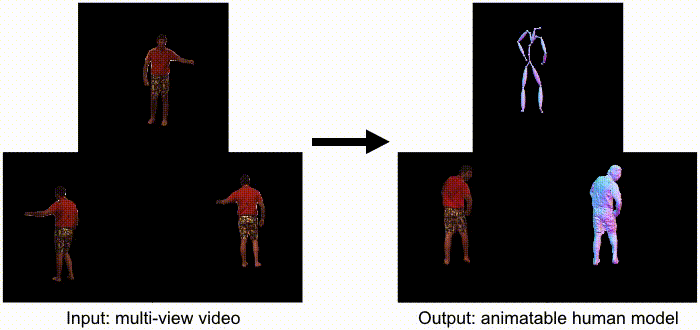News
10/28/2021To make the comparison with Animatable NeRF easier on the Human3.6M dataset, we save the quantitative results at here, which also contains the results of other methods, including Neural Body, D-NeRF, Multi-view Neural Human Rendering, and Deferred Neural Human Rendering.
Project Page | Video | Paper | Data
Animatable Neural Radiance Fields for Modeling Dynamic Human Bodies
Sida Peng, Junting Dong, Qianqian Wang, Shangzhan Zhang, Qing Shuai, Xiaowei Zhou, Hujun Bao
ICCV 2021
Any questions or discussions are welcomed!
Please see INSTALL.md for manual installation.
Since the license of Human3.6M dataset does not allow us to distribute its data, we cannot release the processed Human3.6M dataset publicly. If someone is interested at the processed data, please email me.
We provide the pretrained models at here.
The command lines for test are recorded in test.sh.
Take the test on S9 as an example.
- Download the corresponding pretrained models, and put it to
$ROOT/data/trained_model/deform/aninerf_s9p/latest.pthand$ROOT/data/trained_model/deform/aninerf_s9p_full/latest.pth. - Test on training human poses:
python run.py --type evaluate --cfg_file configs/aninerf_s9p.yaml exp_name aninerf_s9p resume True - Test on unseen human poses:
python run.py --type evaluate --cfg_file configs/aninerf_s9p.yaml exp_name aninerf_s9p_full resume True aninerf_animation True init_aninerf aninerf_s9p test_novel_pose True
Take the visualization on S9 as an example.
-
Download the corresponding pretrained models, and put it to
$ROOT/data/trained_model/deform/aninerf_s9p/latest.pthand$ROOT/data/trained_model/deform/aninerf_s9p_full/latest.pth. -
Visualization:
- Visualize novel views of the 0-th frame
python run.py --type visualize --cfg_file configs/aninerf_s9p.yaml exp_name aninerf_s9p resume True vis_novel_view True begin_ith_frame 0- Visualize views of dynamic humans with 3-th camera
python run.py --type visualize --cfg_file configs/aninerf_s9p.yaml exp_name aninerf_s9p resume True vis_pose_sequence True test_view "3,"- Visualize mesh
# generate meshes python run.py --type visualize --cfg_file configs/aninerf_s9p.yaml exp_name aninerf_s9p vis_posed_mesh True -
The results of visualization are located at
$ROOT/data/novel_view/aninerf_s9pand$ROOT/data/novel_pose/aninerf_s9p.
Take the training on S9 as an example. The command lines for training are recorded in train.sh.
- Train:
# training python train_net.py --cfg_file configs/aninerf_s9p.yaml exp_name aninerf_s9p resume False # training the blend weight fields of unseen human poses python train_net.py --cfg_file configs/aninerf_s9p.yaml exp_name aninerf_s9p_full resume False aninerf_animation True init_aninerf aninerf_s9p - Tensorboard:
tensorboard --logdir data/record/deform
The processed ZJU-MoCap dataset can be downloaded at here.
We provide the pretrained models at here.
The command lines for test are recorded in test.sh.
Take the test on 313 as an example.
- Download the corresponding pretrained models, and put it to
$ROOT/data/trained_model/deform/aninerf_313/latest.pthand$ROOT/data/trained_model/deform/aninerf_313_full/latest.pth. - Test on training human poses:
python run.py --type evaluate --cfg_file configs/aninerf_313.yaml exp_name aninerf_313 resume True - Test on unseen human poses:
python run.py --type evaluate --cfg_file configs/aninerf_313.yaml exp_name aninerf_313_full resume True aninerf_animation True init_aninerf aninerf_313 test_novel_pose True
Take the visualization on 313 as an example.
-
Download the corresponding pretrained models, and put it to
$ROOT/data/trained_model/deform/aninerf_313/latest.pthand$ROOT/data/trained_model/deform/aninerf_313_full/latest.pth. -
Visualization:
- Visualize novel views of the 0-th frame
python run.py --type visualize --cfg_file configs/aninerf_313.yaml exp_name aninerf_313 resume True vis_novel_view True begin_ith_frame 0- Visualize views of dynamic humans with 0-th camera
python run.py --type visualize --cfg_file configs/aninerf_313.yaml exp_name aninerf_313 resume True vis_pose_sequence True test_view "0,"- Visualize mesh
# generate meshes python run.py --type visualize --cfg_file configs/aninerf_313.yaml exp_name aninerf_313 vis_posed_mesh True -
The results of visualization are located at
$ROOT/data/novel_view/aninerf_313and$ROOT/data/novel_pose/aninerf_313.
Take the training on 313 as an example. The command lines for training are recorded in train.sh.
- Train:
# training python train_net.py --cfg_file configs/aninerf_313.yaml exp_name aninerf_313 resume False # training the blend weight fields of unseen human poses python train_net.py --cfg_file configs/aninerf_313.yaml exp_name aninerf_313_full resume False aninerf_animation True init_aninerf aninerf_313 - Tensorboard:
tensorboard --logdir data/record/deform
If you find this code useful for your research, please use the following BibTeX entry.
@inproceedings{peng2021animatable,
title={Animatable Neural Radiance Fields for Modeling Dynamic Human Bodies},
author={Peng, Sida and Dong, Junting and Wang, Qianqian and Zhang, Shangzhan and Shuai, Qing and Zhou, Xiaowei and Bao, Hujun},
booktitle={ICCV},
year={2021}
}
